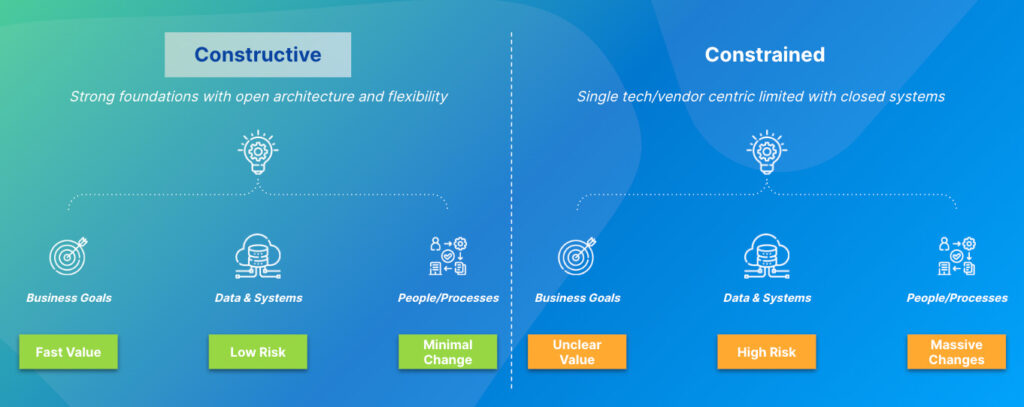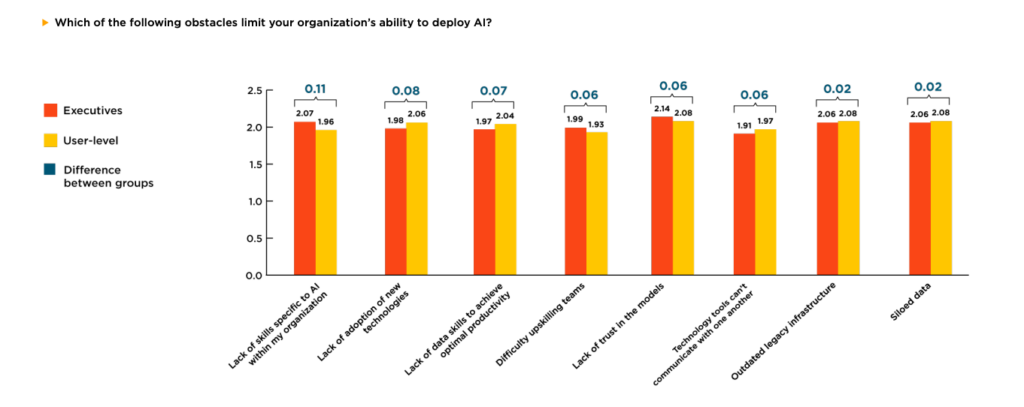
Semarchy always has and always will take a customer-first, trends-second approach to effective Master Data Management.
This means having a deep understanding and focus on rapidly solving your most critical data challenges today, with the flexibility to easily adapt in the future. Our thoughtful, pragmatic approach ensures success through iterative and impactful wins so that these lessons learned can be quickly applied at scale across the organization.
We apply these same principles when evolving our leading unified data platform.
Semarchy’s purposefully designed open architecture empowers you with the flexibility to leverage state-of-the-art web services, enrichers, plugins, and third-party AI/ML capabilities. This has provided hundreds of clients with a robust information infrastructure, augmented by new innovations, without compromising foundational data assets and disrupting existing business processes.
Not coincidentally, our open architecture approach is also heavily utilized by leading LLMs such as OpenAI’s GPT-4, Google’s PaLM, Anthropic’s Claude, and Meta’s LLaMA. There is a reason these AI/ML leaders opt for a constructive, open architecture that provides flexibility to be leveraged for virtually any use case. It is a stark comparison to most MDM vendors that offer AI/ML capabilities that are proprietary and more constrained.
Two Different Approaches to AI/ML in MDM: Constructive vs Constrained
We mentioned in our first blog that we are optimistic about AI’s impact on Master Data Management.
Our priority is to provide the fastest, highest-quality, and most flexible Master Data Management and integration software for any environment and domain. Once we have helped you to establish a trusted information infrastructure, you can confidently leverage any solution, AI/ML or not, to accelerate your goals – with no limitations.
The truth is that Semarchy would rather stick with our strength and focus on MDM, letting state-of-the-art LLMs do the heavy AI/ML lifting. Still, there are two varying approaches to how your critical data assets may be managed.

- Constructive Approach to AI/ML in MDM: Create strong enterprise data foundations with a flexible, open architecture for AI/ML augmentation
- Accelerate business value with state-of-the-art AI/ML
- Reduce risk to core enterprise data and systems
- Minimize disruption for people and processes
VS
- Constrained Approach to AI/ML in MDM: Highly dependent on a single vendor with a closed system and limited to their select AI/ML capabilities
- Unclear business value with limited AI/ML technologies
- Increase risk to core enterprise data and systems
- Introduce disruption for people and processes
Semarchy and LLM leaders choose the constructive approach because we value and prioritize your ability to be flexible and leverage use cases unique and helpful to you. It also provides you with the best benefits and the least amount of risk and disruption.
Why are these three factors critical to adopting AI successfully?
1. Accelerate Business Value with State-of-the-Art AI/ML
AI, like any of its innovative predecessors (Cloud Computing, IoT, AR/VR etc.) needs to provide and ideally accelerate business value for the investment to make sense.
How do disruptive technologies like AI proliferate and accelerate business value?
They focus on their key strengths and provide a foundational but open architecture to enable the flexibility and wide adoption of new use cases for the technology. We can draw on perhaps the most successful example of this approach, OpenAI’s ChatGPT.
ChatGPT’s success is attributed not only to its diligence and research but also the decision to open its ecosystem and API endpoints to enable anyone to leverage its AI/ML capabilities. Even the founders of OpenAI expressed that they couldn’t have imagined the diversity of use cases and creative applications from users.
OpenAI’s approach is similar to how we fundamentally believe that Semarchy provides value by focusing on our strengths to rapidly deliver a robust unified data platform. This gives you the complete flexibility and control to leverage any innovative technologies for your unique needs with minimal risks to your core enterprise data and systems.
2. Reduce Risks to Core Enterprise Data and Systems
Most innovations have a few common yet massive, obstacles that prevent their successful implementation and adoption.
AI is not unique to this challenge, given 42% of AI deployments failed in the last few years. If we examine some of the key data and system frictions that Altair’s research identified, which prevent AI’s success, it is easy to understand the importance of establishing a strong data management strategy before allowing AI to take more control of your data ecosystem.

Some MDM vendors may claim their proprietary AI use cases can deliver promises of productivity, but will not provide you the complete transparency to see exactly where, how, and what has been done to your data before mastering it. Not only will that make you quickly lose control of your most critical data assets, but it will also increase your risk of vendor lock-in and leave little room for future negotiations.
It is also important to note that rules and regulations around data management and AI are still evolving. Without full control of the end-to-end data lifecycle, leaving data in the hands of a vendor’s proprietary AI can subject you to regulatory/compliance headaches, fines, and the need for additional resources to remediate the issue.
Increased regulations around the management of PII data are a primary example
Every business has customers and handles PII (personally identifiable information) data in some capacity. Around 70% of our use cases for master data management involve B2B/B2C or other PII data (employees, partners, suppliers, etc.). These regulations require your match/merge rules for PII data to be completely transparent and deterministic, not probabilistic.
This means regulators must be able to fully determine how a record was created (deterministic), and not via the statistical probability of its attributes from an AI/ML model (probabilistic).
Our decade of experience in helping our customers navigate the complexities of the market, consumer demand, and compliance reinforces and supports our approach. Semarchy’s product architecture is designed to be completely transparent, with no black box rules. We create our products to help you easily adapt to new regulations and business requirements while providing you the flexibility to innovate with new technologies like AI.
And we will never lock you in.
3. Minimize Disruption and Change for People and Processes
Yet again, we return to the importance of people and processes. Our previous blog post already discussed in length how it is important to prioritize the needs of key MDM stakeholders: business users, data stewards, and app designers.
There are plenty of case studies and research that identify people, processes, and culture as the main challenges to success in data and technology initiatives. We are certain your own organizational or anecdotal experiences can back this up.
Our open architectural approach, like those utilized by the leading LLMs, ensures that disruptions and risks to your people and processes are minimal, so change and innovation can happen.
Flexible Platforms and Robust Ecosystems Are the Future for AI
The future of your AI ambitions will not and should not be in the hands of a single MDM, LLM, or technology vendor.
Leaders and top analyst firms like IDC believe that AI/ML will be delivered through a frictionless ecosystem, with vendors continuing to expand their integrations and provide you with choices.
The highest AI maturity and optimized organizations will have skilled staff, agile processes and high-quality data based on a flexible, centrally governed architecture that adapts to ongoing needs (IDC).
A strong information infrastructure and flexibility are the keys to that future.
Do not just trust the analysts, other vendors or us. Trust 97% of your peers who have recommended our leading approach to data in the last 12 months.

Semarchy is here to accelerate your data ambitions.
In the next blog, our Chief Product Officer, FX, will show you the power of this open and constructive architecture by integrating OpenAI in xDM in just five minutes.
Hope to see you there.
-TH

